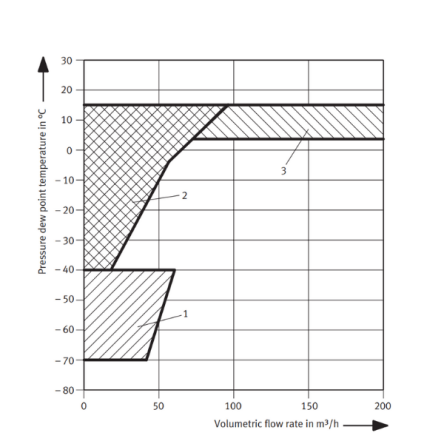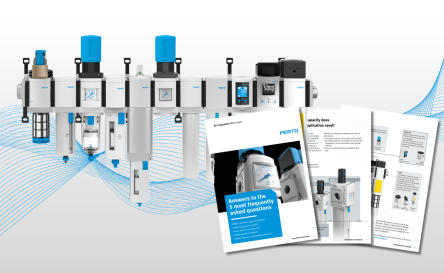What is an adsorption air dryer
An adsorption air dryer is a specialised device designed to remove moisture from compressed air using a drying agent (adsorbent) that attracts and holds water vapour molecules on its surface. Unlike other drying technologies, adsorption dryers can achieve extremely low pressure dew points, making them ideal for applications requiring exceptionally dry air.
How adsorption air dryers work
Adsorption dryers operate using a two-chamber system:

1. In one chamber, moist compressed air passes through the drying agent, which captures water vapour molecules on its surface.
2. Simultaneously, in the second chamber, the previously used drying agent undergoes regeneration to remove accumulated moisture.
3. After a specified time, the airflow switches between chambers, allowing continuous drying while ensuring the drying agent is regularly regenerated.
This dual-chamber design is essential because it allows for uninterrupted operation—while one chamber is actively drying the compressed air, the other is being regenerated.
Want to learn more about compressed air preparation?
📘 Download our whitepaper: Answers to the 5 most frequently asked questions about air prep
Types of regeneration methods
Adsorption dryers use two primary methods for regenerating the drying agent:
Cold regeneration
- Uses a portion of the already dried compressed air to regenerate the drying agent
- This air is expanded to slightly more than 1 bar, making it very dry
- Suitable for short drying/regeneration cycles of approximately 5 minutes
- Works effectively because moisture only accumulates on the surface of the drying agent during these short periods
Process characteristics:
- Simple setup with no external energy requirements
- Ideal for small systems and lower flow rates
- A portion of the dried air is used for regeneration and is no longer available for other purposes
Warm regeneration
- Uses heat to evaporate accumulated water from the drying agent
- Suitable for longer drying/regeneration cycles of approximately 6 to 8 hours
- Heat can be generated either internally (via a heater inside the drying container) or externally (by drawing in and heating ambient air with a fan)
Drying agents used in adsorption dryers
Adsorption dryers use various desiccant materials as adsorbents, including:
- Silica gel
- Activated aluminium oxide
- Molecular sieves (Na, AlO2, SiO2)
These materials have highly porous surfaces with an enormous surface area, allowing them to effectively capture water vapour molecules from the compressed air stream.
Performance factors for adsorption air dryers
Several factors affect the performance of adsorption dryers:
- Inlet pressure: Higher inlet pressure improves efficiency. The inlet pressure should be as high as possible for optimal performance.
- Drying agent maintenance: The hygroscopic drying agent must be replaced regularly to maintain effectiveness.
- Connection materials: Care must be taken with certain connection materials. For example, hemp joints (still used on older, metal pipework) may be air-tight but can draw in water from ambient air and channel it into the system.
Choosing the right drying technology
Selecting the optimal compressed air drying solution requires careful consideration of your specific requirements and the strengths of each technology.
When to choose an adsorption air dryer
Adsorption dryers are the preferred choice when:
- Ultra-low dew points are required: These dryers can achieve pressure dew points as low as -70°C, making them essential for applications with stringent air quality requirements.
- Critical applications: When moisture could severely damage equipment or compromise product quality, such as in pharmaceutical manufacturing or electronics production.
- Extreme conditions: In environments where other drying technologies might not perform adequately.
Limitations to consider: These dryers require regular maintenance and periodic replacement of the drying agent. They also tend to have higher initial and operating costs, especially for models with warm regeneration, and usually take up more space compared to membrane or refrigeration dryers.
Typical Applications
Common applications include:
- Pharmaceutical manufacturing: Ensuring ultra-dry air to prevent contamination and maintain strict quality standards in drug production and packaging.
- Electronics production: Protecting sensitive components and assembly processes from moisture-related defects such as corrosion or short circuits.
- Food and beverage packaging: Providing dry, clean air to avoid product spoilage and ensure hygiene during packaging and processing.
- Instrument air for process control: Supplying moisture-free air to pneumatic instruments and control valves to ensure precise and reliable operation in automated systems.
- Chemical and petrochemical industries: Preventing moisture-induced corrosion and chemical reactions that can compromise safety and product integrity.
- Laboratories and medical facilities: Supporting analytical instruments and medical devices that require consistently dry and contaminant-free air for accurate results and safe operation.

Comparing drying technologies
When evaluating compressed air drying solutions, consider how each technology addresses your needs:
1. Adsorption dryers: Achieve the lowest possible dew points (-70°C) but require regular maintenance and replacement of the drying agent. Ideal for applications demanding extremely dry air.
2. Membrane dryers: Compact and maintenance-free, but typically achieve more moderate dew points. Perfect for point-of-use applications and space-constrained installations.
3. Refrigeration dryers: Suitable for systems up to 1000 m³/h, but cannot achieve the extremely low dew points possible with adsorption technology. Appropriate for general industrial use where moderate dryness is sufficient.
- Areas of application for types of dryer (Source: Hoerbiger-Origa)
The choice between these technologies ultimately depends on your required dryness levels, flow rates, maintenance capabilities, and operational factors. By matching these considerations to the strengths of each technology, you can ensure optimal performance and efficiency in your compressed air system.
Conclusion
Adsorption air dryers represent a powerful solution for applications requiring extremely dry compressed air. Their dual-chamber design, with alternating drying and regeneration cycles, ensures continuous operation. Additionally, their ability to achieve very low-pressure dew points makes them indispensable in many industrial settings.
When selecting a compressed air-drying solution, consider your specific requirements for air quality, flow rate, and dew point. For applications demanding the driest possible air, adsorption dryers offer unmatched performance and reliability.
Remember that proper maintenance, including regular replacement of the drying agent, is essential to ensure optimal performance and longevity of your adsorption air dryer system.

Want to learn more about compressed air preparation?
📘 Download our whitepaper: “Answers to the 5 most frequently asked questions about air prep”
Download now